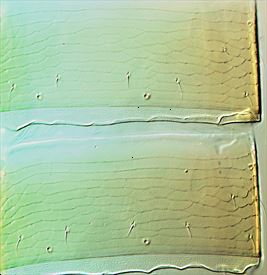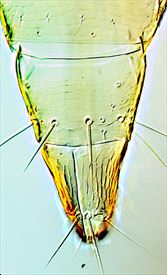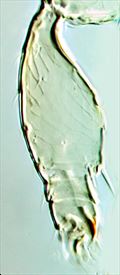Distinguishing features
Both sexes wingless. Body and legs yellow, antennal segments VI–VIII shaded brown, also apex of abdomen. Antennae 8-segmented; segment VI pedicilate, 1.5 times as long as V; segments III–IV with sense cone simple. Head and pronotum without long setae; head longer than wide, ocelli not developed. Meso & metanota transverse. Tarsi 2-segmented. Abdominal tergites and sternites with no posteromarginal craspedum; tergites without discal setae; tergite IX posteromedian setae about 0.6 times as long as lateral pair of setae; sternites with many discal setae.
Male similar but smaller; sternites without pore plates; tergite IX with 2 pairs of stout thorn-like setae.
Related species
Four species are recognized in Aptinothrips, all originally from Europe. These differ from each other in the number of antennal and tarsal segments. Although similar in appearance to A. rufus, the common species, A. stylifer has eight-segmented antennae, two-segmented tarsi, and the posteromedian setae on tergite IX almost as long as the posterolateral setae.
Biological data
Feeding and breeding on the leaves of various grasses (Poaceae), apparently with a preference for slender-leaved species.
Distribution data
Originally from Europe, but widespread in the northern temperate zone, this species has been found in New Zealand only in the South Island, in modified high-country habitats. It has been collected from September to March, largely from moss, lichen, and tussock litter.
Family name
THRIPIDAE, THRIPINAE
Species name
Aptinothrips stylifer Trybom
Original name and synonyms
Aptinothrips stylifer Trybom, 1894: 43
References
Mound LA & Walker AK (1982) Terebrantia (Insecta: Thysanoptera). Fauna of New Zealand 1: 1–113.
Palmer JM (1975) The grass-living genus Aptinothrips Haliday (Thysanoptera: Thripidae). Journal of Entomology (B) 44 (2): 175–188.



